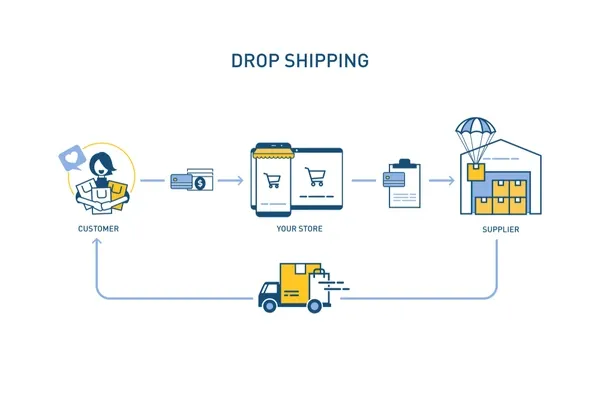
What is Dropshipping?
Dropshipping can be defined as a method of retail business where you outsource production, warehousing and shipping to a third-party supplier. This means that you don’t need to stock products. Whenever any customer orders any product, you buy the product from the supplier and ship it directly to the customer. This is a win-win process for everyone involved as it eliminates the need for inventory, shipping, or packaging.
How Does Dropshipping Model Work?
Dropshipping model connects suppliers, retailers and customers. Let’s take a look at how the process works:
Supplier Stocks Inventory
Suppliers are in charge of keeping the products in stock and then giving them to the retailers to sell. Suppliers are in charge of storing and shipping the items, as and when they are required.
Retailer Create Online Product Listing
Retailers either create an online store or use other e-Commerce platforms to list the products. They are in charge of marketing, price setting and increasing visibility for the customers without stocking the products.
Customer Places an Order
Whenever any customer places an order, the retailer is in charge of processing the transaction, and then forwarding the order details to the supplier.
Supplier Completes the Order
The supplier then picks the product, packs it and ships it directly to the customer under the retailer’s branding for a smooth customer experience.
Retailer Earns a Profit
The retailer’s profit comes from the difference between the price they set and the supplier’s wholesale price.
Benefits of Dropshipping
Dropshipping has several benefits. Some of these are:
Minimal Initial Investment
Exporters do not require any huge capital investment to start the business. They also don’t need warehouses to stock inventory like the traditional export models.
Flexibility and Adaptability
Dropshipping enables exporters to experiment with different products and markets without worrying about the inventory. This means that they can adapt a new strategy from time-to-time as per the growing customer expectations.
Scalability
The dropshipping method is quite scalable as it allows exporters to expand their business operations easily. Whether they want to supply to multiple countries or add new products, suppliers take control of logistics while they focus on growth and expansion.
Wider Market Access
Dropshipping has connected the world and made the entire process hassle-free for exporters. Exporters can now easily collaborate with local suppliers in different regions and ensure faster delivery and customer satisfaction.
Drawbacks of Dropshipping
Some of the drawbacks of dropshipping are :
Less Profit Margins
Profit margin is relatively low as there is no bulk purchasing and the competition can be tough. Retailers either need to sell high volumes or focus on upselling to earn higher profits.
Supplier Reliability
The success or failure of dropshipping business is solely dependent on supplier reliability. Incorrect supply, shipping delays or poor product quality can damage the retailer’s reputation and customer trust.
Tough Competition
The low barrier to entry means a crowded market. Exporters must stand out with niche targeting, superior branding or exceptional customer service.
Customer Service Challenges
Handling returns, refunds, and complaints can be tricky, especially when the retailer doesn’t directly manage inventory or shipping.
Is Dropshipping Right for Your Business?
To understand if dropshipping aligns with your business growth, try to consider these following factors:
Low Investment
If you’re looking to start a business with minimal investment and want to avoid the risks of stocking inventory, dropshipping could be an ideal choice.
Better Marketing Strategy
Dropshipping allows you to focus on branding, marketing and better customer service while suppliers handle production and logistics. If you enjoy creative and strategic tasks, this might be the best option for you.
Flexibility to Explore
Since it is less committed to specific products or niches, you can test market and pivot strategies. This is a great benefit if you are exploring a new market or experimenting with different product categories.
Willingness to Navigate Challenges
Businesses can build stronger supplier relationships and prioritize customer satisfaction if they can navigate challenges like low margins, supplier dependencies and intense competition.
Steps to Start Dropshipping
Starting a dropshipping business can be easy and hassle-free when you follow these steps:
Pick Your Niche
Pick a niche that you prefer and is in alignment with your goals and market demand. You can research different products that are trendy and offer reasonable profit margins.
Choose Trustworthy Suppliers
Pick suppliers that are reliable and can provide quality products and efficient shipping. You can try various online platforms or connect with suppliers to find the best fit for your business.
Start Your Online Store
With the help of platforms like Shopify, WooCommerce or BigCommerce, you can create a professional online store. Include high-res images, interesting product descriptions and clear policies.
Combine Dropshipping Tools
Utilize tools like Oberlo or Spocket to streamline order processing, inventory management, and supplier communication. These tools help automate much of the backend work.
Try and Test Model
Once you’ve set up your store, use tools to track your traffic, conversions and customer feedback. You should reoptimize your strategy with time to improve sales and achieve high customer satisfaction.
High Business Growth
Once you have set up your online platform, diversify your product range, explore new markets and work on your marketing strategy to grow your business.
Conclusion
Dropshipping presents a flexible and low-investment business model, making it an attractive option for entrepreneurs looking to enter the e-commerce world. By leveraging suppliers for inventory and fulfillment, retailers can focus on marketing, customer service, and business growth. However, it’s important to navigate the challenges such as low profit margins, supplier reliability, and tough competition.







Leave a Reply